Demand Response Control of Space Heating in Three Different Building Types in Finland and Germany
Abstract
1. Introduction
2. Materials and Methods
2.1. Structure of the Simulation
2.2. Acceptable Indoor Temperature Ranges
2.3. Weather Data
2.4. Dynamic Price Data
2.5. Building Simulation Software
2.6. Case Building Description
2.6.1. Apartment Building
2.6.2. Cultural Center
2.6.3. Office Building
2.7. Rule-Based Demand Response Control
2.7.1. Control Signal
2.7.2. Control Algorithm
2.7.3. Rebound Prevention by Setpoint Smoothing
3. Results
3.1. Simulation Cases
3.2. Energy Consumtpion and Cost
3.3. Indoor Air Temperature
4. Discussion
5. Conclusions
Author Contributions
Funding
Acknowledgments
Conflicts of Interest
References
- European Comission. Energy Performance of Buildings Directive. Available online: https://ec.europa.eu/energy/topics/energy-efficiency/energy-efficient-buildings/energy-performance-buildings-directive_en#energy-performance-of-buildings-standards (accessed on 12 April 2020).
- Perez-Lombard, L.; Ortiz, J.; Pout, C. A Review on Buildings Energy Consumption Information. Energy Build. 2008, 40, 394. [Google Scholar] [CrossRef]
- IEA. Transition to Sustainable Buildings: Strategies and Opportunities to 2050. Available online: https://doi.org/10.1787/9789264202955-en (accessed on 12 April 2020).
- Tronchin, L.; Manfren, M.; Nastasi, B. Energy efficiency, demand side management and energy storage technologies—A critical analysis of possible paths of integration in the built environment. Renew. Sustain. Energy Rev. 2018, 95, 341–353. [Google Scholar] [CrossRef]
- Alimohammadisagvand, B.; Alam, S.; Ali, M.; Degefa, M.; Jokisalo, J.; Sirén, K. Influence of energy demand response actions on thermal comfort and energy cost in electrically heated residential houses. Indoor Built Environ. 2017, 26, 298–316. [Google Scholar] [CrossRef]
- Salo, S.; Hast, A.; Jokisalo, J.; Kosonen, R.; Syri, S.; Hirvonen, J.; Martin, K. The Impact of Optimal Demand Response Control and Thermal Energy Storage on a District Heating System. Energies 2019, 12, 1678. [Google Scholar] [CrossRef]
- Gelazanskas, L.; Gamage, K. Demand side management in smart grid: A review and proposals for future direction. Sustain. Cities Soc. 2014, 11, 22–30. [Google Scholar] [CrossRef]
- Palensky, P.; Dietrich, D. Demand Side Management: Demand Response, Intelligent Energy Systems, and Smart Loads. IEEE Trans. Ind. Inform. 2011, 7, 381–388. [Google Scholar] [CrossRef]
- Wang, S.; Xue, X.; Yan, C. Building power demand response methods toward smart grid. HVAC R Res. 2014, 20, 665–687. [Google Scholar] [CrossRef]
- Le Dréau, J. Heiselberg, Energy flexibility of residential buildings using short term heat storage in the thermal mass. Energy 2016, 111, 991–1002. [Google Scholar] [CrossRef]
- Kensby, J.; Trüschel, A.; Dalenbäck, J. Potential of residential buildings as thermal energy storage in district heating systems—Results from a pilot test. Appl. Energy 2015, 137, 773–781. [Google Scholar] [CrossRef]
- Lund, H.; Werner, S.; Wiltshire, R.; Svendsen, S.; Thorsen, J.; Hvelplund, F.; Mathiesen, B. 4th Generation District Heating (4GDH) Integrating smart thermal grids into future sustainable energy systems. Energy 2014, 68, 1–11. [Google Scholar] [CrossRef]
- Paiho, S.; Saastamoinen, H. How to develop district heating in Finland? Energy Policy 2018, 122, 668–676. [Google Scholar] [CrossRef]
- Finnish Energy. Energiavuosi 2019, Kaukolämpö (Energy Year 2019, District Heating). Finnish Energy. Helsinki. Finland. 2019. Available online: https://energia.fi/files/4402/Energiavuosi2019_Kaukolampo_MEDIAKUVAT_20200120.pdf (accessed on 15 April 2020). (In Finnish).
- Hillamo, H. Kaukolämpöverkot Suomessa (District Heating Networks in Finland). Finnish Energy. 2019. Available online: https://energia.fi/files/3982/Hillamo_Kaukolampoverkot_Suomessa_KL-paivat_2019_.pdf (accessed on 15 April 2020). (In Finnish).
- Moczko, D. District Heating in Germany. Available online: https://www.euroheat.org/knowledge-hub/district-energy-germany (accessed on 4 August 2020).
- BDEW. Energy Market Germany Bundesverband der Energie- und Wasserwirtschaft e. V. Available online: https://www.bdew.de/media/documents/Pub_20190603_Energy-Market-Germany-2019.pdf (accessed on 4 August 2020).
- Gadd, H.; Werner, S. Daily heat load variations in Swedish district heating systems. Appl. Energy 2013, 106, 47–55. [Google Scholar] [CrossRef]
- Vandermeulen, A.; van Der Heijde, B.; Helsen, L. Controlling district heating and cooling networks to unlock flexibility: A review. Energy 2018, 151, 103–115. [Google Scholar] [CrossRef]
- Lorenzen, P.; Janßen, P.; Winkel, M.; Klose, D.; Kernstock, P.; Schrage, J.; Schubert, F. Design of a Smart Thermal Grid in the Wilhelmsburg district of Hamburg: Challenges and approaches. Energy Procedia 2018, 149, 499–508. [Google Scholar] [CrossRef]
- Vand, B.; Martin, K.; Jokisalo, J.; Kosonen, R.; Hast, A. Demand response potential of district heating and ventilation in an educational office building. Sci. Technol. Built Environ. 2020, 26, 304–319. [Google Scholar] [CrossRef]
- Yoon, J.H.; Baldick, R.; Novoselac, A. Demand response control of residential HVAC loads based on dynamic electricity prices and economic analysis. Sci. Technol. Built Environ. 2016, 22, 705–719. [Google Scholar] [CrossRef]
- Wang, S. Making buildings smarter, grid-friendly, and responsive to smart grids. Sci. Technol. Built Environ. 2016, 22, 629–632. [Google Scholar] [CrossRef]
- Aduda, K.; Labeodan, T.; Zeiler, W.; Boxem, G. Demand side flexibility coordination in office buildings: A framework and case study application. Sustain. Cities Soc. 2017, 29, 139–158. [Google Scholar] [CrossRef]
- Feuerriegel, S.; Neumann, D. Integration scenarios of Demand Response into electricity markets: Load shifting, financial savings and policy implications. Energy Policy 2016, 96, 231. [Google Scholar] [CrossRef]
- Müller, T.; Möst, D. Demand Response Potential: Available when Needed? Energy Policy 2018, 115, 181–198. [Google Scholar] [CrossRef]
- Alimohammadisagvand, B.; Jokisalo, J.; Siren, K. Comparison of four rule-based demand response control algorithms in an electrically and heat pump-heated residential building. Appl. Energy 2018, 209, 167–179. [Google Scholar] [CrossRef]
- Vahid, A. A novel cost-optimizing demand response control for a heat pump heated residential building. Build. Simul. 2018, 11, 533–547. [Google Scholar] [CrossRef]
- Alimohammadisagvanda, B.; Jokisaloa, J.; Kilpelaeinena, S.; Alib, M.; Sirena, K. Cost-optimal thermal energy storage system for a residential building with heat pump heating and demand response control. Appl. Energy 2016, 174, 275–287. [Google Scholar] [CrossRef]
- Mishra, A.; Jokisalo, J.; Kosonen, R.; Kinnunen, T.; Ekkerhaugen, M.; Ihasalo, H.; Martin, K. Demand response events in district heating: Results from field tests in a university building. Sustain. Cities Soc. 2019, 47, 101481. [Google Scholar] [CrossRef]
- Sisäilmayhdistys ry (Finnish Society of Indoor Air Quality). Sisäilmastoluokitus 2018 (Classification of Indoor Environment 2018). 2018. Available online: https://www.rakennustietokauppa.fi/sivu/tuote/rt-07-11299-sisailmastoluokitus-2018-sisaympariston-tavoitearvot-suunnitteluohjeet-ja-tuotevaatimukset/2742604 (accessed on 20 February 2020). (In Finnish).
- EN 15251. Indoor Environmental input Parameters for Design and Assessment of Energy Performance of Buildings Addressing Indoor Air Quality, Thermal Environment, Lighting and Acoustics; The European Committee for Standardization (CEN): Brussels, Belgium, 2007. [Google Scholar]
- Jylhä, K.; Kalamees, T.; Tietäväinen, H.; Ruosteenoja, K.; Jokisalo, J.; Hyvönen, R.; Ilomets, S.; Saku, S.; Hutila, A. Rakennusten Energialaskennan Testivuosi 2012 ja Arviot Ilmastonmuutoksen Vaikutuksista (Test Reference Year 2012 for Building Energy Demand and Impacts of Climate Change). Finnish Meteorological Institute. Available online: https://helda.helsinki.fi/bitstream/handle/10138/33069/2011nro6.pdf?sequence=1&isAllowed=y (accessed on 20 February 2020). (In Finnish).
- Kalamees, T.; Jylhae, K.; Tietaevaeinen, H.; Jokisalo, J.; Ilomets, S.; Hyvonen, R.; Saku, S. Development of weighting factors for climate variables for selecting the energy reference year according to the EN ISO 15927-4 standard. Energy Build. 2012, 47, 53–60. [Google Scholar] [CrossRef]
- Ministry of the Environment. D3 Finnish Code of Building Regulation. Rakennusten Energiatehokkuus (Energy Efficiency of Buildings). Regulations and Guidelines; Ministry of the Environment: Helsinki, Finland, 2012. (In Finnish)
- Deutscher Wetterdienst (DWD). Handbuch, Ortsgenaue Testreferenzjahre von Deutschland für Mittlere, Extreme und Zukünftige Witterungsverhältnisse (Handbook, Locally Accurate Test Reference Years from Germany for Medium, Extreme and Future Weather Conditions). 2017. Available online: https://www.bbsr.bund.de/BBSR/DE/forschung/programme/zb/Auftragsforschung/5EnergieKlimaBauen/2013/testreferenzjahre/try-handbuch.pdf?__blob=publicationFile&v=3 (accessed on 14 September 2020). (In German).
- Deutscher Wetterdienst (DWD). Projektbericht, Ortsgenaue Testreferenzjahre von Deutschland für Mittlere, Extreme und Zukünftige Witterungsverhältnisse (Project Report, Locally Accurate Test Reference Years from Germany for Medium, Extreme and Future Weather Conditions). 2017. Available online: https://www.bbsr.bund.de/BBSR/DE/forschung/programme/zb/Auftragsforschung/5EnergieKlimaBauen/2013/testreferenzjahre/try-projektbericht.pdf?__blob=publicationFile&v=3 (accessed on 14 September 2020). (In German).
- Finnish Meteorological Institute. Heating Degree Days. [Website]. Available online: https://en.ilmatieteenlaitos.fi/heating-degree-days (accessed on 20 September 2020).
- Sandrock, M.; Maaß, C.; Weisleder, S.; Kaufmann, C.; Fuß, G.; Sørensen, A.; Jensen, L.L.; Radmann, K. Erneuerbare Energien im Fernwärmenetz Hamburg—Teil 1: Handlungsoptionen für einen kurzfristigen Ersatz des Kraftwerks Wedel. HIC Hamburg Institut Consulting GmbH. (Renewable Energies for District Heating in Hamburg—Part 1: Options for Action for a Short-Term Replacement of the Wedel Combined Heat and Power Plant). 2016. Available online: https://www.hamburg-institut.com/images/pdf/studien/161207%20%20Bericht%20BUE.pdf (accessed on 10 November 2020). (In German).
- Bundesnetzagentur für Elektrizität, Gas, Telekommunikation, Post und Eisenbahnen (Publisher). Biogas-Monitoringbericht 2014—Bericht der Bundesnetzagentur Über Die Auswirkungen der Sonderregelungen für die Einspeisung von Biogas in das Erdgasnetz. (Biogas Monitoring Report 2014—Report of the German Bundesnetzagentur on the Effects of the Special Regulations for the Feed-in of Biogas into the Natural Gas Grid). Bonn. 2014. Available online: https://www.bundesnetzagentur.de/SharedDocs/Downloads/DE/Sachgebiete/Energie/Unternehmen_Institutionen/ErneuerbareEnergien/Biogas/Biogas_Monitoring/Biogas_Monitoringbericht_2014.pdf?__blob=publicationFile&v=1 (accessed on 10 November 2020). (In German).
- BDEW Bundesverband der Energie- und Wasserwirtschaft e.V. (Publisher). Umsetzungshilfe zum EEG 2012—Empfehlungen für Netzbetreiber zur Umsetzung des Gesetzes für den Vorrang Erneuerbarer Energien (Erneuerbare-Energien-Gesetz—EEG) und der Damit Verbundenen Verordnungen. (Implementation Assistance for the EEG 2012—Recommendations for Grid Operators for the Implementation of the Act on the Priority of Renewable Energies (Renewable Energy Sources Act—EEG) and the Associated Ordinances.) Berlin. 2013. Available online: https://www.bdew.de/media/documents/Awh_20130516_BDEW-Umsetzungshilfe-EEG-2012.pdf (accessed on 10 November 2020). (In German).
- Vattenfall Wärme Hamburg GmbH (Publisher). Preisblatt 2. Quartal 2019. (Price sheet 2nd Quarter 2019). 2019. Available online: https://waerme.hamburg/media/71/download/Preisblatt_Hamburg_Q2-2019.pdf?v=2 (accessed on 2 March 2020).
- Sahlin, P. Modelling and Simulation Methods for Modular Continuous Systems in Buildings. Ph.D. Thesis, Royal Institute of Technology (KTH), Stockholm, Sweden. Available online: https://www.equa.se/dncenter/thesis.pdf (accessed on 2 March 2020).
- Kropf, S.; Zweifel, G. Validation of the Building Simulation Program IDA-ICE According to CEN Hochschule Für Technik+Architektur Luzern. Available online: http://www.equaonline.com/iceuser/validation/ICE_vs_prEN%2013791.pdf (accessed on 2 March 2020).
- EQUA. Validation of IDA Indoor Climate and Energy 4.0 with respect to CEN Standards EN 15255-2007 and EN 15265-EQUA Simulation AB. Available online: http://www.equaonline.com/iceuser/validation/CEN_VALIDATION_EN_15255_AND_15265.pdf (accessed on 2 March 2020).
- Achermann, M.; Zweifel, G. RADTEST—Radiant Heating and Cooling Test Cases. A Report of Task IEA. Available online: http://www.equaonline.com/iceuser/validation/old_stuff/RADTEST_final.pdf (accessed on 2 March 2020).
- Moinard, S.; Guyon, G. Empirical Validation of EDF ETNA and GENEC Test-Cell Models. A Report of Task IEA. Available online: http://www.equaonline.com/iceuser/validation/old_stuff/ETNA.pdf (accessed on 2 March 2020).
- Bring, A.; Sahlin, P.; Vuolle, M. Models for Building Indoor Climate and Energy Simulation. A Report of IEA Task IEA. Available online: https://www.equa.se/dncenter/T22Brep.pdf (accessed on 2 March 2020).
- Ministry of the Environment. D3 Finnish Code of Building Regulation. Rakennusten Energiatehokkuus (Energy Efficiency of Buildings). Regulations and Guidelines; Ministry of the Environment: Helsinki, Finland, 1985. (In Finnish)
- Ministry of Environment. Finnish Code of Building Code Energiatehokkuus (Energy Efficiency). Ministry of Environment. Helsinki. Finland. 2017. Available online: https://www.edilex.fi/data/rakentamismaaraykset/Ohje_Rakennuksen_energiankulutuksen_ja_lammitystehontarpeen_laskenta_20-12-2017.pdf (accessed on 4 May 2020). (In Finnish)
- EN Ventilation for non-residential buildings. Performance Requirements for Ventilation and Room-Conditioning Systems; The European Committee for Standardization (CEN): Brussels, Belgium, 2007. [Google Scholar]
- TABULA WebTool. Available online: http://webtool.building-typology.eu/#bm (accessed on 5 February 2020).
- Loga, T.; Imkeller-Benjes, U. Energiepaß Heizung/Warmwasser (Energy Demand Heating/Hot Water). 1997. Available online: https://www.delta-q.de/export/sites/default/de/downloads/hessischer_energiepass.pdf (accessed on 5 February 2020). (In German).
- Ministry of Environment. 1010/2017 Ympäristöministeriön Asetus Uuden Rakennuksen Energiatehokkuudesta (Decree 1010/2017 Ministry of Environment’s Decree on New Building’s Energy Efficiency); Ministry of Environment: Helsinki, Finland, 2017. (In Finnis)
- FINVAC (The Finnish Association of HVAC Societies). Opas Asuinrakennusten Ilmanvaihdon Mitoitukseen (The Guidelines of Ventilation Dimensioning in Apartment Building). FINVAC. 2017. Available online: https://finvac.org/wp-content/uploads/2020/06/Opas_asuinrakennusten_ilmanvaihdon_mitoitukseen_2017.pdf (accessed on 20 March 2020). (In Finnis).
- Mikola, A.; Kalamees, T.; Kõiv, T. Performance of ventilation in Estonian apartment buildings. Energy Procedia 2017, 132, 963–968. [Google Scholar] [CrossRef]
- FINVAC (The Finnish Association of HVAC Societies). Opas Ilmanvaihdon Mitoitukseen Muissa Kuin Asuinrakennuksissa (The guidelines of Ventilation Dimensioning in other Buildings than Apartment Building). FINVAC. 2017. Available online: https://finvac.org/wp-content/uploads/2020/06/Opas_ilmanvaihdon_mitoitukseen_muissa_kuin_asuinrakennuksissa_2017.pdf (accessed on 20 March 2020). (In Finnis).
- Seppänen, O.; Brelih, N.; Goeders, G.; Litiu, A. Health based Ventilation Guidelines for Europe. Work Package Existing Buildings, Building Codes, Ventilation Standards and Ventilation in Europe. The Final Report. REHVA. Available online: https://webgate.ec.europa.eu/chafea_pdb/assets/files/pdb/20091208/20091208_d05_oth5_en_ps.pdf (accessed on 2 August 2020).
- Martin, K. Demand Response of Heating and Ventilation within Educational Office Buildings. Master’s Thesis, Aalto University, Espoo, Finland. Available online: https://aaltodoc.aalto.fi/handle/123456789/29149 (accessed on 2 April 2020).
- Thermal Insolation Ordinance. Available online: https://www.bbsr-energieeinsparung.de/EnEVPortal/DE/Archiv/WaermeschutzV/WaermeschutzV1977/Download/WaermeschutzV77.pdf?__blob=publicationFile&v=1 (accessed on 3 April 2020).
- Vinha, J.; Korpi, M.; Kalamees, T.; Jokisalo, J.; Eskola, L.; Palonen, J.; Kurnitski, J.; Aho, H.; Salminen, M.; Salminen, K.; et al. Asuinrakennusten ilmanpitävyys, Sisäilmasto ja Energiatalous (Residential Buildings Airtightness, indoor Climate and Energy Economy). Research Report Tampere University of Technology. Tampere. Finland. Available online: https://tutcris.tut.fi/portal/fi/publications/asuinrakennusten-ilmanpitavyys-sisailmasto-ja-energiatalous(6c30917a-bbbf-4c38-a623-9ed88978384f).html (accessed on 4 May 2020).
- Shan, K.; Wang, S.; Yan, C.; Xiao, F. Building demand response and control methods for smart grids: A review. Sci. Technol. Built Environ. 2016, 22, 692. [Google Scholar] [CrossRef]
- Kontu, K.; Vimpari, J.; Penttinen, P.; Junnila, S. City Scale Demand Side Management in Three Different-Sized District Heating Systems. Energies 2018, 11, 3370. [Google Scholar] [CrossRef]
- Salo, S.; Jokisalo, J.; Syri, S.; Kosonen, R. Individual temperature control on demand response in a district heated office building in Finland. Energy 2019, 180, 946. [Google Scholar] [CrossRef]
- Noussan, M.; Jarre, M.; Poggio, A. Real operation data analysis on district heating load patterns. Energy 2017, 129, 70–78. [Google Scholar] [CrossRef]
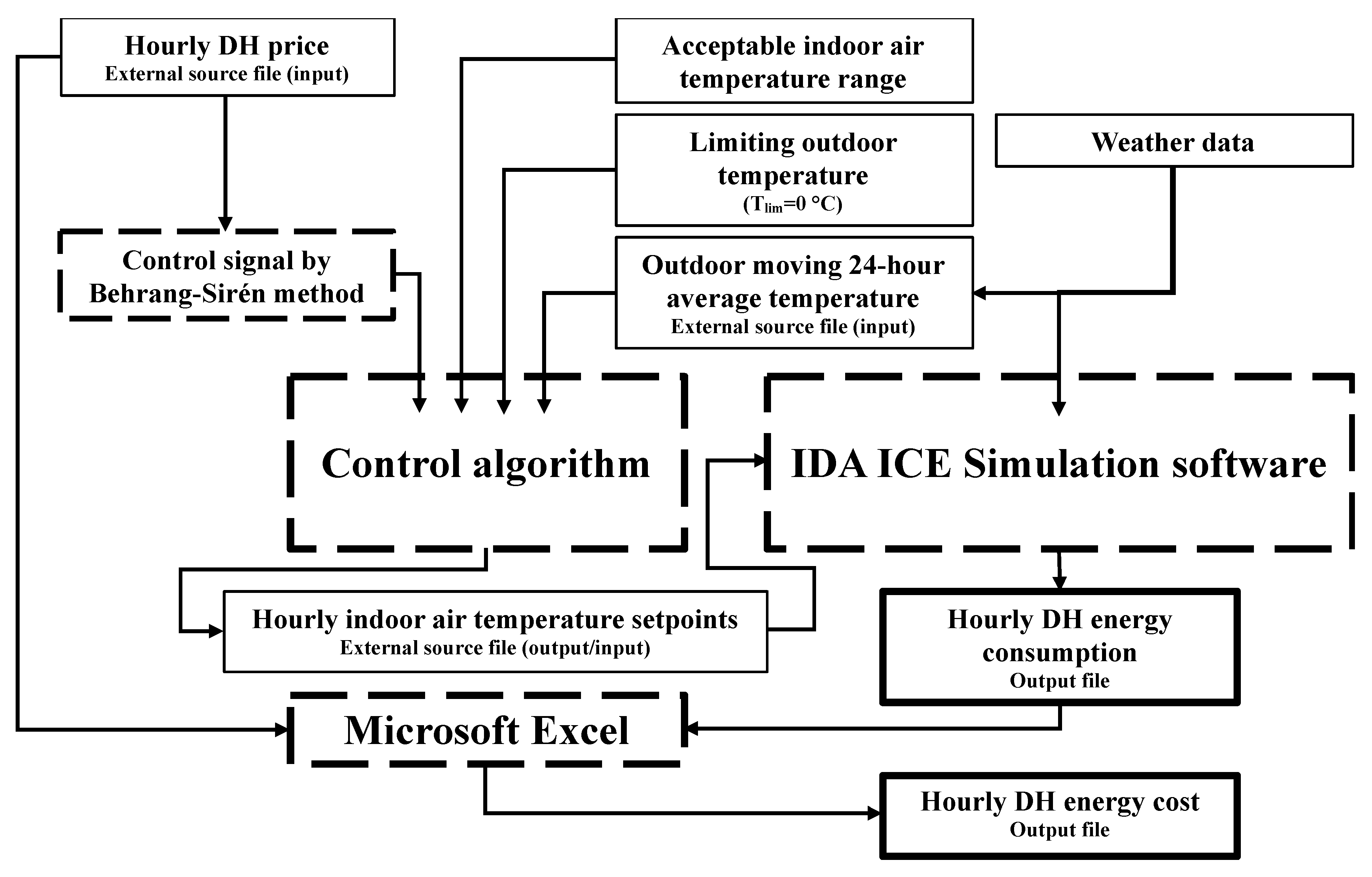
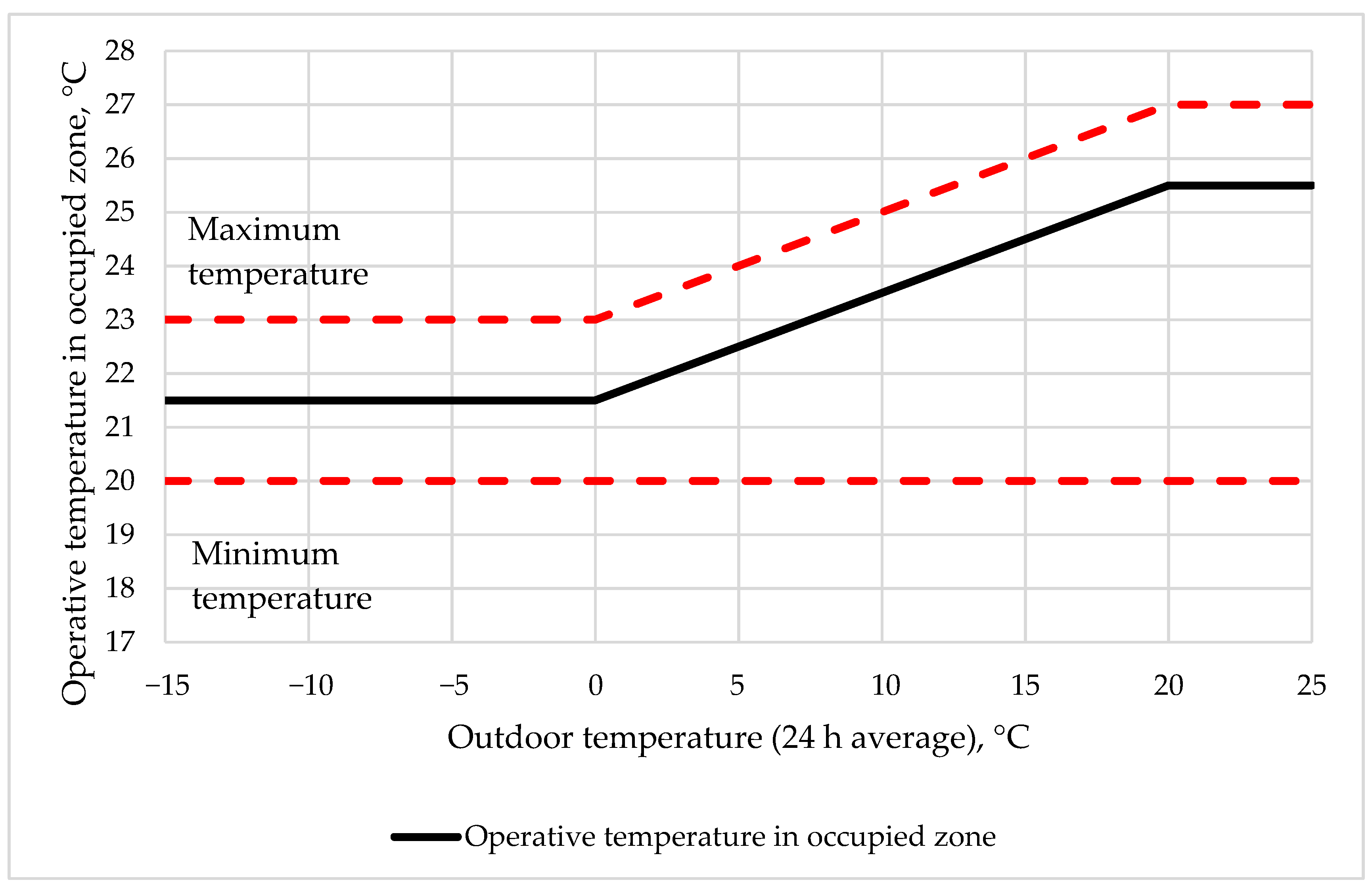


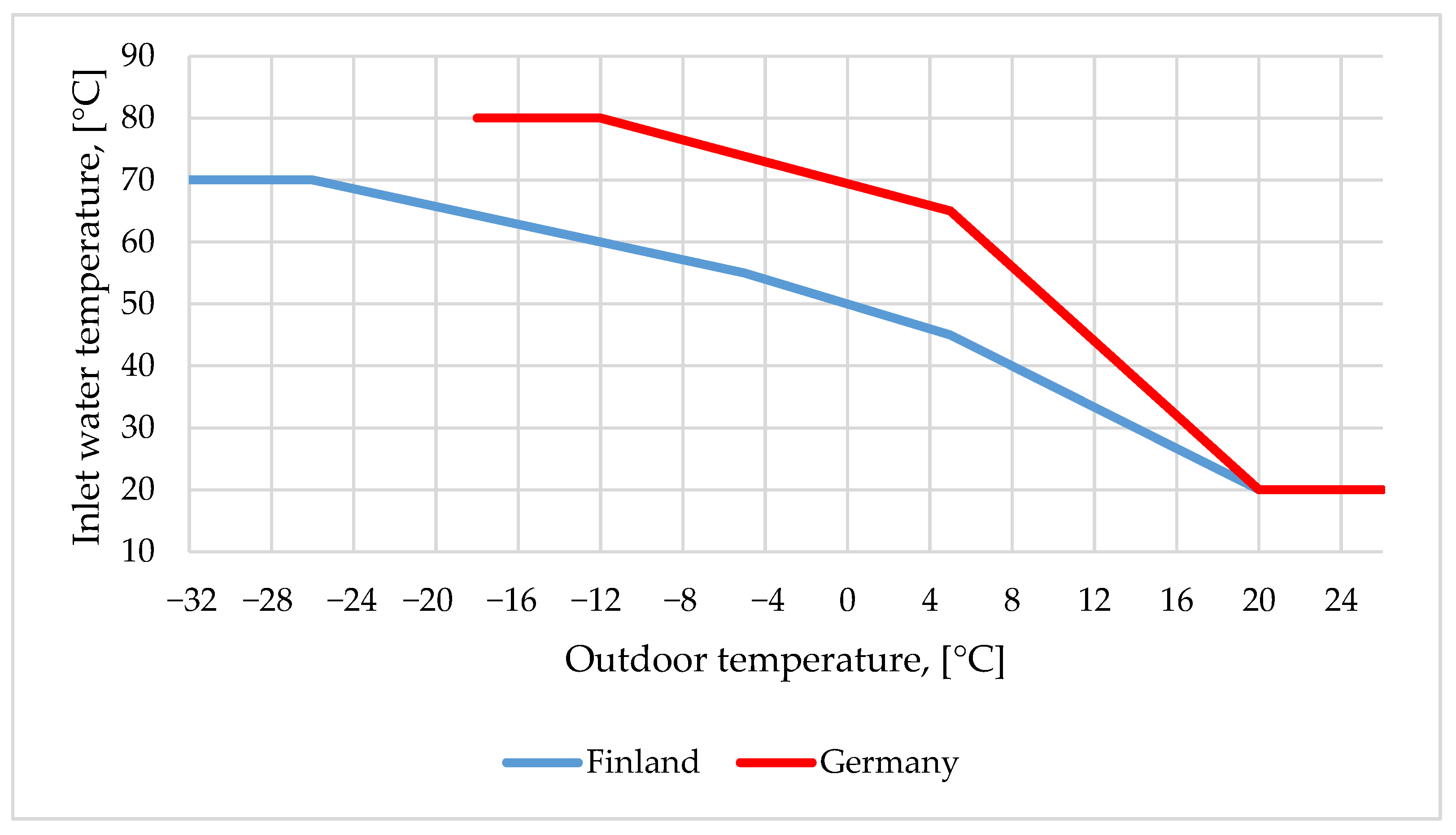


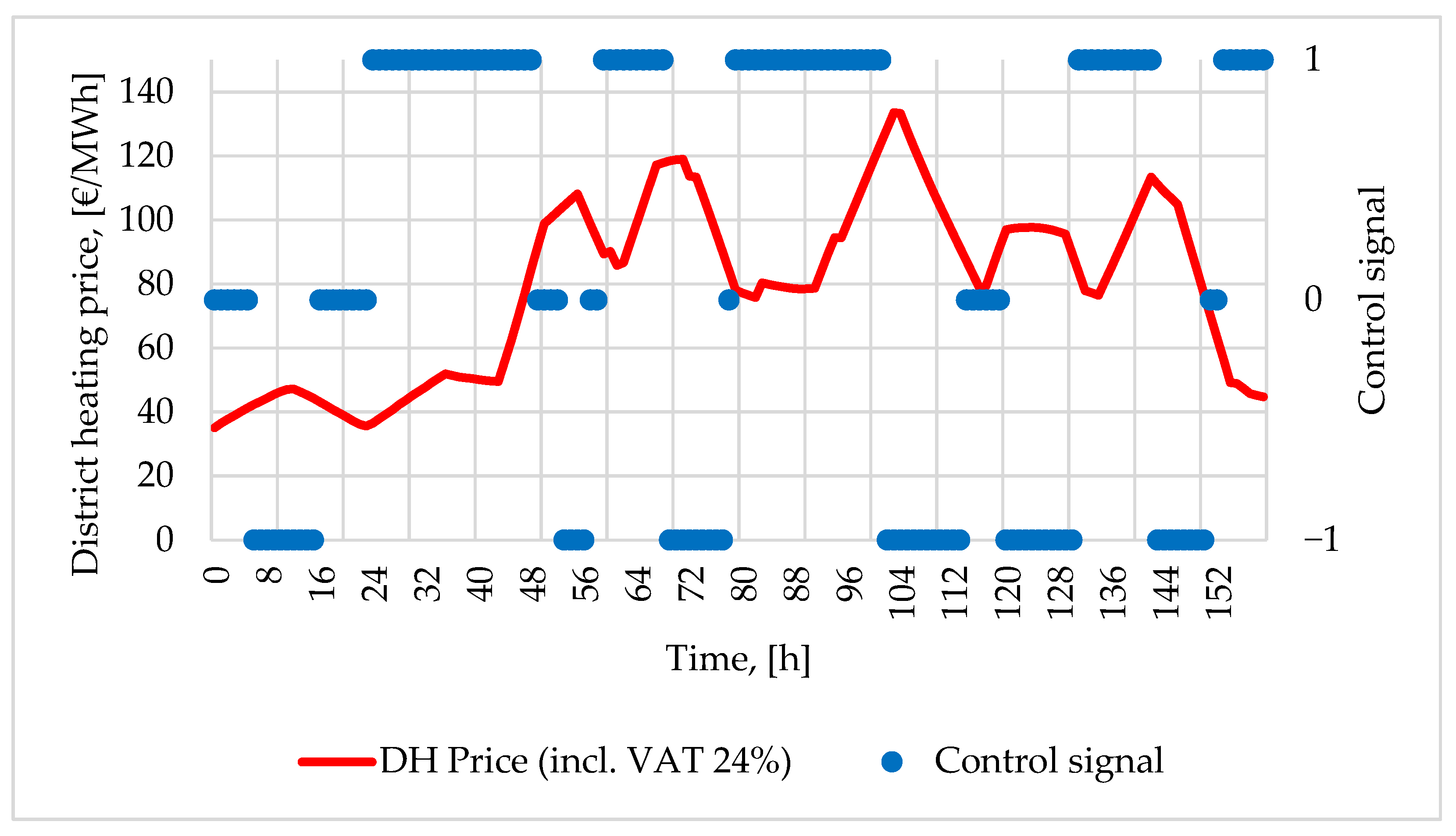



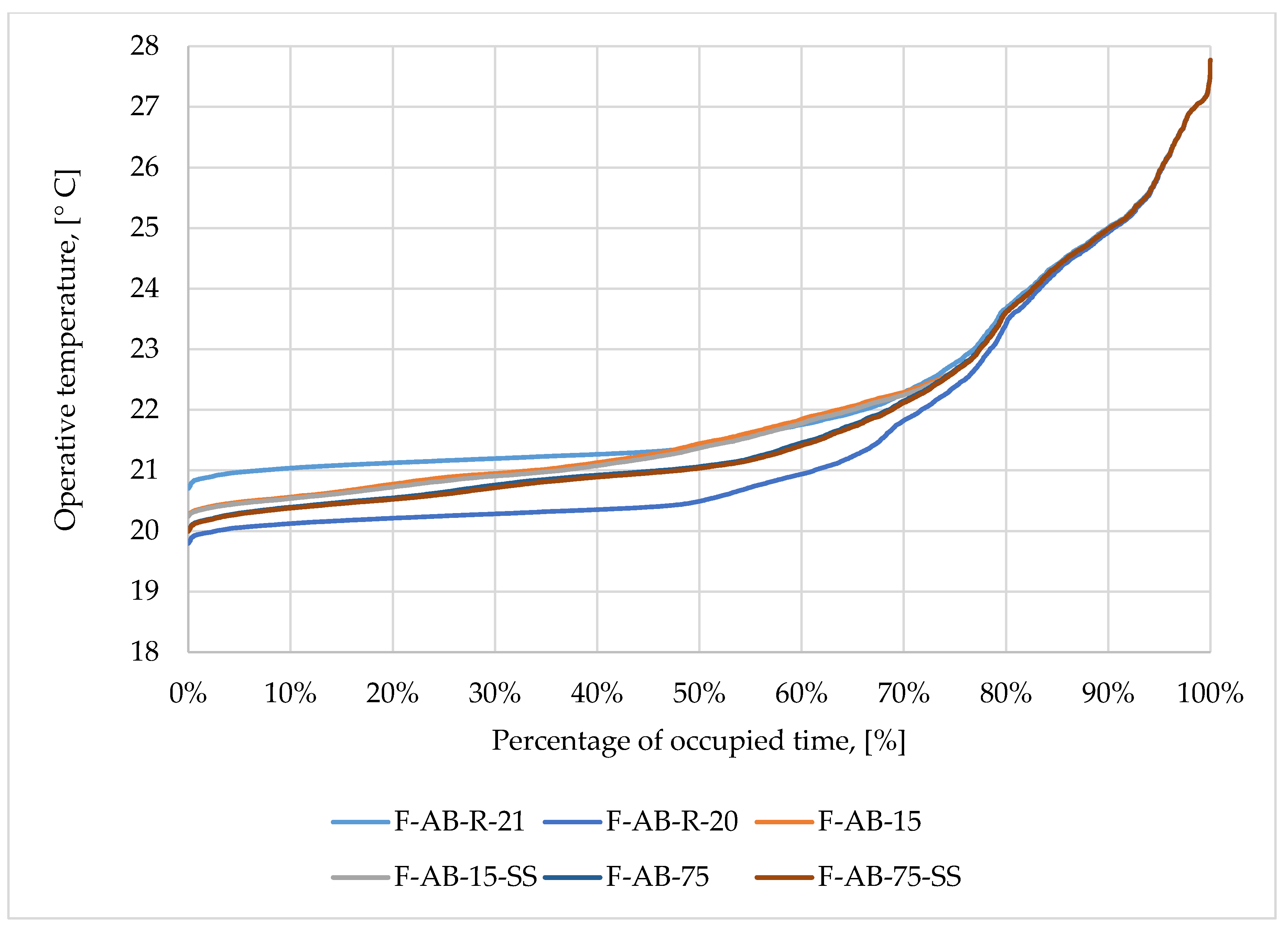


| Simulation Cases | Hourly DH Price Data | Average | Maximum | Minimum | Standard Deviation |
|---|---|---|---|---|---|
| Finnish | Synthetic Finnish price data | 50.62 | 145.40 | 9.14 | 15.37 |
| German | Actual German price data | 64.08 | 90.58 | 19.73 | 8.65 |
| General Building Information | Apartment Building | Cultural Center | Office Building |
|---|---|---|---|
| Heated net floor area, (m2) | 4885 | 3937 | 2383 |
| Building volume (ext. dimension), (m3) | 12,000 | 16,314 | 8556 |
| Envelope area, (m2) | 4780 | 6921 | 3855 |
| Window to envelope ratio, (%) | 7.6 | 8.8 | 9.5 |
| Property | Finland | Germany | |
|---|---|---|---|
| Construction year | 1990’s | Early 1930’s | |
| U-values, (W/m2K) | |||
| External wall | 0.28 | 1.70 | |
| Roof | 0.22 | 1.40 | |
| Ground slab | 0.36 | 1.0 | |
| Windows | 1.0 | 3.0 | |
| Air leakage rate n50, (L/h) | 1.0 | 7.0 | |
| Heating system | Water radiators | ||
| Supply/return temperatures of heating system, (°C) | 70/40 | 80/60 | |
| Space heating design power at design temperature, (kW) | 169 | 225 | |
| Specific design power in design temperature, (W/m2) | 35 | 46 | |
| Ventilation system | |||
| Mechanical exhaust, (L/s,m2) | 0.39 | - | |
| Natural ventilation average air exchange rate, (1/h) | - | 0.24 (apartments avg. 0.18 L/s,m2) | |
| Cooling | No | No | |
| Property | Finland | Germany | |
|---|---|---|---|
| Construction year | 1990’s | Early 1980’s | |
| U-values, (W/m2K) | |||
| External wall | 0.28 | 0.20 | |
| Roof | 0.22 | 0.19 | |
| Ground slab | 0.36 | 0.28 | |
| Windows | 1.0 | 3.0 | |
| Air leakage rate n50, (L/h) | 2.0 | 3.0 | |
| Heating system | |||
| System type | Water radiators, Floor heating (basement, entrance hall) | ||
| Supply/return temperatures of heating system, (°C) | 70/40 | 70/40 | |
| Space heating design power in design temperature, (kW) | 229 | 175 | |
| Specific design power in design temperature, (W/m2) | 58 | 44 | |
| Ventilation system | |||
| System type | |||
| Mechanical supply and exhaust ventilation (CAV) (8 a.m.–10 p.m.) | Air change rate, (L/s,m2) | 0.35–4.5 | - |
| Zone | Basement, toilets and technical spaces | - | |
| Mechanical supply and exhaust ventilation (VAV with CO2 control) with heat recovery (η = 65%) (8 a.m.–10 p.m.) | Air change rate, (L/s,m2) | 0.35–5.4 | - |
| Zone | Other spaces | - | |
| Mechanical supply and exhaust ventilation (CAV) without heat recovery (8 a.m.–10 p.m.) (7 a.m.–10 p.m., basement) | Air change rate, (L/s,m2) | - | 1.7–2.36 |
| Zone | - | Kitchen, restaurant, basement and hall | |
| Mechanical exhaust ventilation (CAV) (always on) | Air change rate, (L/s,m2) | - | 2.5–4.5 |
| Zone | - | Toilets | |
| Natural ventilation (always on) | Air change rate, (L/s,m2) | - | 0.2–0.43 |
| Zone | - | Other spaces | |
| Cooling | Yes | No | |
| Property | Finland | Germany | |
|---|---|---|---|
| Construction year | 1990’s | Early 1980’s | |
| U-values, (W/m2K) | |||
| External wall | 0.28 | 0.20 | |
| Roof | 0.22 | 0.19 | |
| Ground slab | 0.36 | 0.28 | |
| Windows | 1.0 | 3.0 | |
| Air leakage rate n50, (1/h) | 1.6 | 4.5 | |
| Heating system | |||
| System type | Water radiators | ||
| Supply/return temperatures of heating system, (°C) | 70/40 | 70/40 | |
| Space heating design power in design temperature, (kW) | 129 | 101 | |
| Specific design power in design temperature, (W/m2) | 54 | 42 | |
| Ventilation system | |||
| System type | |||
| Mechanical supply and exhaust ventilation (VAV with CO2 control) heat recovery (η = 65%) (Workdays 6 a.m.–6 p.m.) | Air change rate, (L/s,m2) | 0.35–3.0 | - |
| Zone | Meeting rooms | - | |
| Mechanical supply and exhaust ventilation (CAV) (Workdays 6 a.m.–6 p.m.) | Air change rate, (L/s,m2) | 0.35–1.5 | - |
| Zone | Office rooms and hallways | - | |
| Mechanical supply and exhaust ventilation (CAV) without heat recovery (Workdays 6 a.m.–6 p.m.) | Air change rate, (L/s,m2) | - | 2.1 |
| Zone | - | Whole building | |
| Cooling | Yes | No | |
| Country and Building Type | Case | Control Algorithm | Control Signal’s Marginal Value (€/MWh) | Indoor Air Temperature (°C) | Setpoint Smoothing | Night-Time Setback |
|---|---|---|---|---|---|---|
| Finland, Apartment | F-AB-R-21 Reference case 1 | - | - | 21 | - | No |
| F-AB-R-20 Reference case 2 | - | - | 20 | - | No | |
| F-AB-15 | DR | +/−15 | 20–23 | - | No | |
| F-AB-15-SS | DR | +/−15 | 20–23 | Yes | No | |
| F-AB-75 | DR | +/−75 | 20–23 | - | No | |
| F-AB-75-SS | DR | +/−75 | 20–23 | Yes | No | |
| Finland, Cultural Center | F-CC-R-21 Reference case 1 | - | - | 21 | - | No |
| F-CC-R-20 Reference case 2 | - | - | 20 | - | No | |
| F-CC-15 | DR | +/−15 | 20–23 | - | No | |
| F-CC-15-SS | DR | +/−15 | 20–23 | Yes | No | |
| F-CC-75 | DR | +/−75 | 20–23 | - | No | |
| F-CC-75-SS | DR | +/−75 | 20–23 | Yes | No | |
| F-CC-15-SS-NT | DR+NT | +/−15 | 20–23 | Yes | Yes | |
| F-CC-75-SS-NT | DR+NT | +/−75 | 20–23 | Yes | Yes | |
| Finland, Office | F-OB-R-21 Reference case 1 | - | - | 21 | - | No |
| F-OB-R-20 Reference case 2 | - | - | 20 | - | No | |
| F-OB-15 | DR | +/−15 | 20–23 | - | No | |
| F-OB-15-SS | DR | +/−15 | 20–23 | Yes | No | |
| F-OB-75 | DR | +/−75 | 20–23 | - | No | |
| F-OB-75-SS | DR | +/−75 | 20–23 | Yes | No | |
| F-OB-15-SS-NT | DR+NT | +/−15 | 20–23 | Yes | Yes | |
| F-OB-75-SS-NT | DR+NT | +/−75 | 20–23 | Yes | Yes |
| Country and Building Type | Case | Control Algorithm | Control Signal’s Marginal Value (€/MWh) | Indoor air Temperature (°C) | Setpoint Smoothing | Night-Time Setback |
|---|---|---|---|---|---|---|
| Germany, Apartment | G-AB-R-21 Reference case 1 | - | - | 21 | - | No |
| G-AB-R-20 Reference case 2 | - | - | 20 | - | No | |
| G-AB-75-SS | DR | +/−75 | 20–23 | Yes | No | |
| Germany, Cultural Center | G-CC-R-21 Reference case 1 | - | - | 21 | - | No |
| G-CC-R-20 Reference case 2 | - | - | 20 | - | No | |
| G-CC-75-SS-NT | DR + NT | +/−75 | 20–23 | Yes | Yes | |
| Germany, Office | G-OB-R-21 Reference case 1 | - | - | 21 | - | No |
| G-OB-R-20 Reference case 2 | - | - | 20 | - | No | |
| G-OB-75-SS-NT | DR + NT | +/−75 | 20–23 | Yes | Yes |
| Case | Space Heating | Total DH Energy | Saving Potential | |||
|---|---|---|---|---|---|---|
| Specific Demand (kWh/m2, a) | Specific Costs (€/m2,a) | Specific Demand (kWh/m2, a) | Specific Costs (€/m2,a) | DH Energy (Δ%) | Cost (Δ%) | |
| F-AB-R-21 Reference case 1 | 54.4 | 3.6 | 90.5 | 5.4 | 0.0% | 0.0% |
| F-AB-R-20 Reference case 2 | 50.1 | 3.3 | 86.1 | 5.2 | 4.8% | 4.4% |
| F-AB-15 | 54.0 | 3.5 | 90.0 | 5.4 | 0.5% | 0.7% |
| F-AB-15-SS | 53.9 | 3.5 | 90.0 | 5.4 | 0.5% | 0.7% |
| F-AB-75 | 52.9 | 3.4 | 89.0 | 5.2 | 1.7% | 3.1% |
| F-AB-75-SS | 52.9 | 3.4 | 88.9 | 5.2 | 1.7% | 3.2% |
| Case | Space Heating | Total DH Energy | Saving Potential | |||
|---|---|---|---|---|---|---|
| Specific Demand (kWh/m2, a) | Specific Costs (€/m2,a) | Specific Demand (kWh/m2, a) | Specific Costs (€/m2,a) | DH Energy (Δ%) | Cost (Δ%) | |
| G-AB-R-21 Reference case 1 | 75.7 | 5.4 | 96.8 | 6.7 | 0.0% | 0.0% |
| G-AB-R-20 Reference case 2 | 68.3 | 4.9 | 89.3 | 6.2 | 7.7% | 7.6% |
| G-AB-75-SS | 73.0 | 5.2 | 94.1 | 6.5 | 2.8% | 3.2% |
| Case | Space Heating | Total DH Energy | Saving Potential | |||
|---|---|---|---|---|---|---|
| Specific Demand (kWh/m2, a) | Specific Costs (€/m2,a) | Specific Demand (kWh/m2, a) | Specific Costs (€/m2,a) | DH Energy (Δ%) | Cost (Δ%) | |
| F-CC-R-21 Reference case 1 | 69.0 | 4.5 | 95.8 | 6.3 | 0.0% | 0.0% |
| F-CC-R-20 Reference case 2 | 60.5 | 4.1 | 88.7 | 5.9 | 7.5% | 6.1% |
| F-CC-15 | 68.5 | 4.5 | 95.4 | 6.3 | 0.5% | 0.7% |
| F-CC-15-SS | 68.3 | 4.5 | 95.2 | 6.3 | 0.6% | 0.9% |
| F-CC-75 | 66.6 | 4.3 | 93.9 | 6.1 | 2.0% | 3.1% |
| F-CC-75-SS | 66.5 | 4.3 | 93.8 | 6.1 | 2.1% | 3.2% |
| F-CC-15-SS-NT | 65.3 | 4.3 | 92.5 | 6.1 | 3.4% | 3.0% |
| F-CC-75-SS-NT | 64.0 | 4.2 | 91.5 | 6.0 | 4.5% | 4.6% |
| Case | Space Heating | Total DH Energy | Saving Potential | |||
|---|---|---|---|---|---|---|
| Specific Demand (kWh/m2, a) | Specific Costs (€/m2,a) | Specific Demand (kWh/m2, a) | Specific Costs (€/m2,a) | DH Energy (Δ%) | Cost (Δ%) | |
| G-CC-R-21 Reference case 1 | 78.9 | 5.6 | 122.0 | 8.6 | 0.0% | 0.0% |
| G-CC-R-20 Reference case 2 | 68.1 | 4.9 | 111.2 | 7.8 | 8.8% | 8.6% |
| G-CC-75-SS-NT | 69.5 | 4.9 | 112.7 | 7.9 | 7.7% | 8.1% |
| Case | Space Heating | Total DH Energy | Saving Potential | |||
|---|---|---|---|---|---|---|
| Specific Demand (kWh/m2, a) | Specific Costs (€/m2,a) | Specific Demand (kWh/m2, a) | Specific Costs (€/m2,a) | DH Energy (Δ%) | Cost (Δ%) | |
| F-OB-R-21 Reference case 1 | 59.1 | 3.8 | 74.4 | 4.7 | 0.0% | 0.0% |
| F-OB-R-20 Reference case 2 | 54.0 | 3.5 | 69.9 | 4.5 | 6.1% | 5.5% |
| F-OB-15 | 58.6 | 3.7 | 73.9 | 4.7 | 0.7% | 1.5% |
| F-OB-15-SS | 58.4 | 3.7 | 73.7 | 4.7 | 1.0% | 1.8% |
| F-OB-75 | 56.7 | 3.5 | 72.2 | 4.4 | 3.0% | 6.7% |
| F-OB-75-SS | 56.6 | 3.5 | 72.1 | 4.4 | 3.1% | 6.8% |
| F-OB-15-SS-NT | 54.9 | 3.6 | 70.6 | 4.5 | 5.2% | 4.1% |
| F-OB-75-SS-NT | 53.5 | 3.4 | 69.3 | 4.4 | 6.8% | 7.8% |
| Case | Space Heating | Total DH Energy | Saving Potential | |||
|---|---|---|---|---|---|---|
| Specific Demand (kWh/m2, a) | Specific Costs (€/m2,a) | Specific Demand (kWh/m2, a) | Specific Costs (€/m2,a) | DH Energy (Δ%) | Cost (Δ%) | |
| G-OB-R-21 Reference case 1 | 58.8 | 4.2 | 118.3 | 8.2 | 0.0% | 0.0% |
| G-OB-R-20 Reference case 2 | 50.3 | 3.6 | 109.8 | 7.6 | 7.2% | 7.2% |
| G-OB-75-SS-NT | 50.9 | 3.6 | 110.3 | 7.6 | 6.8% | 7.8% |
| Case | Degree Hours, (°Ch) | Total Number of Hours, (h) |
|---|---|---|
| F-AB-R-21 Reference case 1 | 0 | 0 |
| F-AB-R-20 Reference case 2 | 13 | 237 |
| F-AB-15 | 0 | 0 |
| F-AB-15-SS | 0 | 0 |
| F-AB-75 | 0 | 0 |
| F-AB-75-SS | 0 | 3 |
| Case | Degree Hours, (°Ch) | Total Number of Hours, (h) |
|---|---|---|
| G-AB-R-21 Reference case 1 | 0 | 0 |
| G-AB-R-20 Reference case 2 | 67 | 801 |
| G-AB-75-SS | 4 | 76 |
| Case | Degree Hours, (°Ch) | Total Number of Hours, (h) |
|---|---|---|
| F-CC-R-21 Reference case 1 | 0 | 0 |
| F-CC-R-20 Reference case 2 | 9 | 91 |
| F-CC-15 | 0 | 2 |
| F-CC-15-SS | 0 | 3 |
| F-CC-75 | 1 | 20 |
| F-CC-75-SS | 2 | 22 |
| F-CC-15-SS-NT | 7 | 60 |
| F-CC-75-SS-NT | 13 | 94 |
| Case | Degree Hours, (°Ch) | Total Number of Hours, (h) |
|---|---|---|
| G-CC-R-21 Reference case 1 | 0 | 0 |
| G-CC-R-20 Reference case 2 | 12 | 106 |
| G-CC-75-SS-NT | 9 | 70 |
| Case | Degree Hours, (°Ch) | Total Number of Hours, (h) |
|---|---|---|
| F-OB-R-21 | 0 | 0 |
| F-OB-R-20 | 13 | 129 |
| F-OB-15 | 0 | 0 |
| F-OB-15-SS | 0 | 0 |
| F-OB-75 | 1 | 14 |
| F-OB-75-SS | 1 | 16 |
| F-OB-15-SS-NT | 61 | 193 |
| F-OB-75-SS-NT | 114 | 320 |
| Case | Degree Hours, (°Ch) | Total Number of Hours, (h) |
|---|---|---|
| G-OB-R-21 Reference case 1 | 0 | 0 |
| G-OB-R-20 Reference case 2 | 16 | 146 |
| G-OB-75-SS-NT | 71 | 214 |
Publisher’s Note: MDPI stays neutral with regard to jurisdictional claims in published maps and institutional affiliations. |
© 2020 by the authors. Licensee MDPI, Basel, Switzerland. This article is an open access article distributed under the terms and conditions of the Creative Commons Attribution (CC BY) license (http://creativecommons.org/licenses/by/4.0/).
Share and Cite
Suhonen, J.; Jokisalo, J.; Kosonen, R.; Kauppi, V.; Ju, Y.; Janßen, P. Demand Response Control of Space Heating in Three Different Building Types in Finland and Germany. Energies 2020, 13, 6296. https://doi.org/10.3390/en13236296
Suhonen J, Jokisalo J, Kosonen R, Kauppi V, Ju Y, Janßen P. Demand Response Control of Space Heating in Three Different Building Types in Finland and Germany. Energies. 2020; 13(23):6296. https://doi.org/10.3390/en13236296
Chicago/Turabian StyleSuhonen, Janne, Juha Jokisalo, Risto Kosonen, Ville Kauppi, Yuchen Ju, and Philipp Janßen. 2020. "Demand Response Control of Space Heating in Three Different Building Types in Finland and Germany" Energies 13, no. 23: 6296. https://doi.org/10.3390/en13236296
APA StyleSuhonen, J., Jokisalo, J., Kosonen, R., Kauppi, V., Ju, Y., & Janßen, P. (2020). Demand Response Control of Space Heating in Three Different Building Types in Finland and Germany. Energies, 13(23), 6296. https://doi.org/10.3390/en13236296






